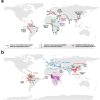Inferring language dispersal patterns with velocity field estimation
- PMID: 38167834
- PMCID: PMC10761963
- DOI: 10.1038/s41467-023-44430-5
Inferring language dispersal patterns with velocity field estimation
Abstract
Reconstructing the spatial evolution of languages can deepen our understanding of the demic diffusion and cultural spread. However, the phylogeographic approach that is frequently used to infer language dispersal patterns has limitations, primarily because the phylogenetic tree cannot fully explain the language evolution induced by the horizontal contact among languages, such as borrowing and areal diffusion. Here, we introduce the language velocity field estimation, which does not rely on the phylogenetic tree, to infer language dispersal trajectories and centre. Its effectiveness and robustness are verified through both simulated and empirical validations. Using language velocity field estimation, we infer the dispersal patterns of four agricultural language families and groups, encompassing approximately 700 language samples. Our results show that the dispersal trajectories of these languages are primarily compatible with population movement routes inferred from ancient DNA and archaeological materials, and their dispersal centres are geographically proximate to ancient homelands of agricultural or Neolithic cultures. Our findings highlight that the agricultural languages dispersed alongside the demic diffusions and cultural spreads during the past 10,000 years. We expect that language velocity field estimation could aid the spatial analysis of language evolution and further branch out into the studies of demographic and cultural dynamics.
© 2024. The Author(s).
Conflict of interest statement
The authors declare no competing interests.
Figures



Similar articles
-
Phylogenetic evidence reveals early Kra-Dai divergence and dispersal in the late Holocene.Nat Commun. 2023 Oct 30;14(1):6924. doi: 10.1038/s41467-023-42761-x. Nat Commun. 2023. PMID: 37903755 Free PMC article.
-
Assessing the importance of cultural diffusion in the Bantu spread into southeastern Africa.PLoS One. 2019 May 8;14(5):e0215573. doi: 10.1371/journal.pone.0215573. eCollection 2019. PLoS One. 2019. PMID: 31067220 Free PMC article.
-
Cultural phylogeography of the Bantu Languages of sub-Saharan Africa.Proc Biol Sci. 2013 May 8;280(1762):20130695. doi: 10.1098/rspb.2013.0695. Print 2013 Jul 7. Proc Biol Sci. 2013. PMID: 23658203 Free PMC article.
-
Tracing population movements in ancient East Asia through the linguistics and archaeology of textile production.Evol Hum Sci. 2020 Feb 14;2:e5. doi: 10.1017/ehs.2020.4. eCollection 2020. Evol Hum Sci. 2020. PMID: 37588355 Free PMC article. Review.
-
Demography and language competition.Hum Biol. 2009 Apr;81(2-3):181-210. doi: 10.3378/027.081.0305. Hum Biol. 2009. PMID: 19943743 Review.
References
-
- Bellwood, P. First farmers: the origins of agricultural societies. (John Wiley & Sons, 2023).
Publication types
MeSH terms
Grants and funding
LinkOut - more resources
Full Text Sources
Miscellaneous

